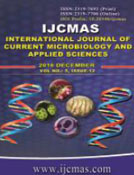


 National Academy of Agricultural Sciences (NAAS)
National Academy of Agricultural Sciences (NAAS)

|
PRINT ISSN : 2319-7692
Online ISSN : 2319-7706 Issues : 12 per year Publisher : Excellent Publishers Email : editorijcmas@gmail.com / submit@ijcmas.com Editor-in-chief: Dr.M.Prakash Index Copernicus ICV 2018: 95.39 NAAS RATING 2020: 5.38 |
Respiratory tract infections (RTI) are the commonest health problem demanding frequent consultation and hospitalisation. It causes morbidity & mortality in young children & elderly people. Moreover, in recent years, there has been dramatic rise in antibiotic resistance among respiratory pathogens. This study aims to identify the prevalence of community acquired respiratory tract infections, among patient visiting to respiratory clinic. To find out the prevalence of bacterial and fungal etiology, with interest to multidrug resistance (MDR) in respiratory infections. This study also focuses the respiratory health of people in Wayanad district of Kerala where the climate throughout the year is wet and cold. The study was carried out in 185 respiratory samples of patient presenting with symptoms of respiratory tract infections. Samples were collected and processed in the Microbiology Laboratory of DM WIMS Hospital, Meppady, Wayanad within a period of 2 months (October 2015– December 2015). The samples were collected & processed by standard microbiological technique. Antimicrobial susceptibility testing was performed by modified Kirby Bauer method as per the CLSI guidelines. Out of the 185 samples cases, only 100(54.05%) showed significant growth, 72(38.91%) samples were showing normal pharyngeal flora & 13(7.02) sputum samples were without showing any growth and was reported as no growth. Infection rate in males (72%) was higher than in female (28%) and was reported more in age group of 66-75 years. Out of the 100 samples showing significant growth 78 were bacteria and 22 were fungi. Out of the 78 cases with bacterial etiology, 18(23.07%) of them were Streptococcus pyogens, 4(5.15) streptococcus pneumonia, 17(21.79%) Enterococcus species, 16 (20.51%) Klebsiella, 9 (11.53%) Pseudomonas. Out of the 22 isolates of fungi 15(68.18%) were Candida albicans, 5(22.72%) were Candida tropicalis& 2(9.10%) were Aspergillus flavus. Prevalance of ESBL’s were identified in 6 out of 78 cases, 2 MRSA , 1 MBL & also 3 MDR were Identified Conclusion. This study reveals that most of the respiratory infections are due to bacteria and the commonest infective agent was Streptococcus pyogene. RTI remains an important cause of morbidity & mortality in worldwide. Therefore correct identification of the causative pathogens & their antibiotic susceptibility pattern in turn helps to select best antibiotic therapy which ultimately helps for diagnosis & treatment of the patients.
 |
 |
 |
 |
 |